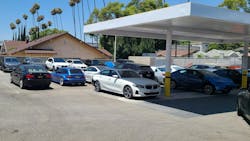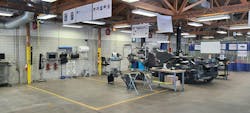Working with a dealership can bring in steady work for your shop, but it can also bring in a constant stream of headaches.
One of the main sources of work your shop can expect when working with a dealership is their fleet of loaner vehicles. Andrew Batenhorst, body shop manager of Pacific BMW in Glendale, California, says that working on those loaner vehicles will present its own set of unique challenges.
Over the years, his shop has developed a method to help increase the efficiency of handling these requests and to reduce the overall hassle when dealing with them.
The Problem
Though there are many issues that can come up while dealing with a damaged loaner vehicle, Batenhorst says the issues usually start with the coverage investigation process.
“Since this is typically a temporary vehicle provided for a service customer, you have a separate contract. Not every dealership is going to have the same contract,” Batenhorst says. “When the claim originates, the person in the dealership who is trying to gather that info may not have all the facts of what happened.”
When the person you’re working with at the dealership doesn’t have all the facts, that can create confusion. Batenhorst says his shop has sometimes found out that there's an exclusion and a particular carrier doesn't cover a temporary vehicle when it gets in an accident. In addition, most dealerships are not self-insuring these vehicles, and they want to avoid their own insurance as much as possible.
“Most shops won’t begin working on a car until they know the coverage on that claim is going to be good,” Batenhorst says. “You need to have a good understanding of how that's going to be handled.”
The Solution
Batenhorst says, unfortunately, there’s no one-size-fits-all solution to dealing with loaner vehicles. Still, his shop has developed a method to maximize the productivity and profit that comes from working on loaners.
The first step is to figure out what the best-case scenario is for a car. Typically, most dealerships will want to sell a loaner vehicle. However, after an accident that may not be feasible.
“If that car has structural damage or airbags deployed, now the dealership can't sell that as a certified pre-owned,” Batenhorst says. “As a shop, you have to have a good conversation with someone in the sales department at that dealership to figure out the best thing for that car.”
Batenhorst says in his shop, his team then writes a preliminary estimate without disassembly or full diagnostics and then presents it to the dealership.
“We ask what the desired outcome is. They may wholesale it, they may total it, or they may want to fix it. Those are the three main routes to go,” he says. “The decision-making process involves multiple people from the dealership, and you should have those conversations early so you don't end up wasting time.”
He says a “good, hour-long meeting” with everyone who's involved with the decision-making process for loaner vehicles on the dealership side before beginning repairs essential. He also says you need to create a standard process for how those vehicles are handled.
“That's the only way to ensure that you're going to cover everything appropriately. Make sure the information is very clear about when a vehicle is returned to a dealership, you know who on the front line is gathering info from the customer, who is updating the loaner contracts with the proper in- and out-dates, and so on,” he says. “Once you get that figured out, now you can get the car in your shop and begin your normal diagnosis process.”
The Aftermath
From here is where the process starts to get a little trickier. Batenhorst says there are three routes a loaner vehicle can take. The first is the subrogation route. That route involves a lot of risk, Batenhorst says, but can sometimes pay off big.
“Sometimes it's worked out well and we've gotten paid down to the penny of what we've requested. Sometimes you don't, and the subrogation team redlines your invoice and decides not to pay for something,” he says. “Either way, if you take that route, be prepared that you may not be paid for a long time.”
The second option is to treat it like it's a standard repair claim in your shop where an adjuster comes out to negotiate the job with you and you go over the normal approval process. That also has issues, Batenhorst says, because these are vehicles that need to be repaired with OEM parts because the dealership needs to resell this car.
“Now you run into the trouble of insurance refusing to pay for things and you're going through the standard process that you'd go through with a customer, and now the dealership needs to be notified of any discrepancy on the part types or labor operations,” he says. “There needs to be a point person from the dealership side who's involved in all these discussions.”
The third option is to use a third-party claims administration company, which acts as your representative when dealing with insurance companies in some scenarios. They can handle the diminished value aspect of the loaner car or loss of use, and they can assist with the process of totaling a vehicle as well. The downside is that there are fees associated with using a third-party company, and it also takes a longer time to go through the process.
Batenhorst says all three are essential tools to have in your toolbox, and learning when to use each method effectively is key in handling loaner vehicles. Sometimes, he says that involves prioritizing what’s best for the customer, not necessarily what’s best for you.
“I'm in the business of repairing cars. That's how I make my money. I want to fix them, but it's not always my decision. There are times where a salesperson will say ‘this is not a good car for us to fix,’" Batenhorst says. “At the end of the day, if you want to have a good relationship with the dealership, you have to effectively manage this for them, and you may have to swallow your pride a little bit on jobs where you know you're not going to get that work. That pays off in the long run because they see you as an effective partner for them.”
The Takeaway
Loaner vehicles can be a hassle, but proper planning and having the foresight to know what common problems are is key. Batenhorst says going through all the steps he listed will save a lot of headaches throughout the journey.
“I wish I could say there’s a silver bullet, but there isn’t. Every scenario is different,” he says. “Remember your place as the shop and don't overextend yourself. It all folds into building a relationship with the dealership.”
Working with loaner vehicles will always come as part of the deal when working with dealerships. Batenhorst says patience and consistency will help make the partnership worth it in the end.
“You've got to be smart about how you're going to handle it. It took my shop a long time to get good at the process, and we're constantly learning how to get better. It's not an impossible mountain to climb.”
About the Author

Noah Brown
Noah Brown is a freelance writer and former senior digital editor for 10 Missions Media, where he facilitated multimedia production several of the company's publications.




